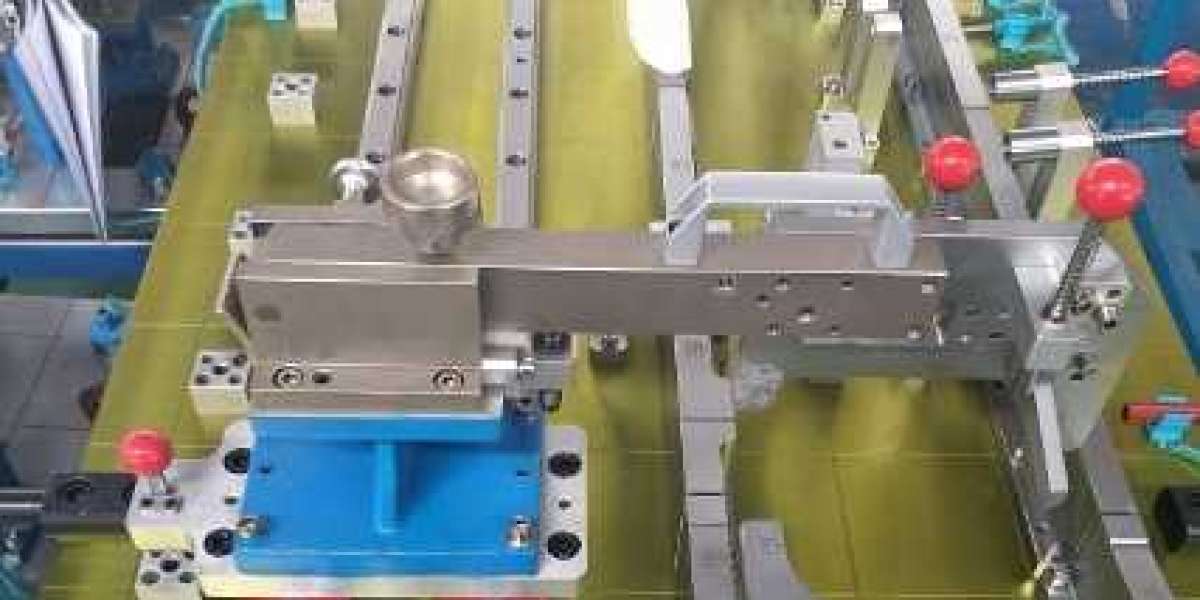Introduction to Tooling and Fixturing in Engineering
Welcome to the world of engineering tooling and fixturing! Whether you're a seasoned engineer or just starting out in the field, understanding these essential components is crucial for successful manufacturing processes. From improving efficiency to ensuring precision, tooling and fixturing play a vital role in turning ideas into reality. In this comprehensive guide, we'll explore the different types of tooling and fixturing, their benefits, materials used, factors to consider when designing them, as well as best practices for implementation. So buckle up and get ready to dive into the fascinating world of engineering tooling and fixturing with adaqiao Machinery!
Types of Tooling and Fixturing
When it comes to engineering tooling and fixturing, there is a wide range of options available. Each type serves a specific purpose and can greatly enhance the efficiency and accuracy of various manufacturing processes.
One common type of tooling is jigs. Jigs are devices that hold and guide materials during drilling, cutting, or shaping operations. They ensure precise alignment and help eliminate errors caused by manual handling. Another popular option is fixtures, which are used to securely hold workpieces in place during machining or assembly processes. Fixtures often have adjustable components to accommodate different sizes or shapes.
In addition to jigs and fixtures, there are specialized tools like clamps, vices, chucks, arbors, mandrels, and more. These tools provide additional support and stability for specific tasks such as welding or milling.
there are also tooling systems, which are collections of various tools and accessories specifically designed to work together. These can include things like modular tooling systems, quick-change systems, or multi-axis tooling systems.
Another important type of tooling is cutting tools. These can include drills, end mills, reamers, taps, and other types of cutting implements used for shaping or removing material from a workpiece.
Some types of fixturing are specialized for specific industries or applications. For example, in the automotive industry, there are fixtures designed specifically for welding car frames or assembling engines. In aerospace manufacturing, there may be fixtures used for precise positioning and alignment of aircraft components.
In addition to traditional mechanical fixturing and tooling, there are also advanced options like computer numerical control (CNC) fixtures and 3D printing jigs. These technologies allow for automated and customizable production processes with higher levels of precision.
Overall, the types of tooling and fixturing available vary greatly depending on the specific needs and requirements of a particular manufacturing process. Choosing the right type of tooling and fixturing can greatly improve efficiency, accuracy, and quality in production.
Moreover, the use of specialized fixtures and tooling can also reduce the risk of injury to workers, as they provide additional support and stability for materials being worked on. Properly selected and implemented tooling and fixturing can have a significant impact on the success and profitability of a manufacturing operation.
Benefits of Using Tooling and Fixturing
Tooling and fixturing play a crucial role in engineering projects, offering numerous benefits that can greatly enhance productivity and accuracy. One of the key advantages is increased efficiency. By using tooling and fixturing, engineers can streamline their processes and reduce the time it takes to complete tasks.
Another benefit is improved consistency. Tooling and fixturing provide a standardized approach to manufacturing or assembly processes, ensuring that each component is produced with precision and uniformity. This helps eliminate variations in quality, resulting in higher levels of reliability for the end product.
Cost savings are also a significant advantage of using tooling and fixturing. With proper planning and design, these tools can help reduce waste by minimizing errors or rework. Additionally, they enable efficient use of materials by optimizing cutting paths or reducing scrap rates.
Moreover, safety is enhanced when utilizing appropriate tooling and fixtures. These devices are designed to securely hold workpieces in place during machining or assembly operations, minimizing the risk of accidents caused by slippage or improper positioning.
Tooling and fixturing promote scalability within an organization. Once established, these tools can be replicated across multiple production lines or facilities without sacrificing accuracy or performance.
In conclusion: Tooling and fixturing offer several significant benefits for engineering projects including increased efficiency, improved consistency, cost savings,
enhanced safety,and scalability potential
Common Materials Used in Tooling and Fixturing
When it comes to tooling and fixturing, choosing the right materials is crucial for ensuring optimal performance and durability. Various materials can be used depending on the specific requirements of the application. Here are some common materials that are frequently utilized in engineering tooling and fixturing:
1. Steel: Steel is one of the most popular choices due to its high strength, toughness, and resistance to wear. It can withstand heavy loads without deforming or breaking, making it ideal for applications that involve machining or assembly processes.
2. Aluminum: Known for its lightweight properties, aluminum is often chosen when weight reduction is a priority. Despite being lighter than steel, aluminum still offers good strength and corrosion resistance.
3. Cast iron: This material is valued for its excellent vibration damping capabilities, making it suitable for applications where stability and precision are essential.
4. Plastics: Certain plastic materials like nylon or acetal can be used in tooling and fixturing when non-metal components are required or when there's a need for electrical insulation.
5. Composite materials: Composites such as carbon fiber reinforced polymers offer superior strength-to-weight ratios compared to traditional metals while providing exceptional stiffness and dimensional stability.
Each material has its own advantages and considerations based on factors like cost, temperature range, chemical compatibility, tensile strength requirements, etc. Therefore, carefully assessing these factors will help determine which material suits your specific needs best.
Factors to Consider When Designing Tooling and Fixturing
Designing tooling and fixturing is a crucial step in the engineering process. It requires careful consideration of various factors to ensure optimal performance and efficiency. Here are some key considerations to keep in mind:
1. Functionality: The first thing to consider is the intended purpose of the tool or fixture. What tasks will it need to perform? Does it need to hold parts securely or provide support during machining processes? Understanding its function will help guide the design process.
2. Compatibility: Another important factor is compatibility with existing machinery and equipment. The tool or fixture should be designed in such a way that it can easily integrate into the manufacturing process without causing any disruptions.
3. Material Selection: Choosing the right materials for tooling and fixturing is essential for durability, stability, and precision. Factors such as strength, heat resistance, corrosion resistance, and dimensional stability should be considered when selecting materials.
4. Ergonomics: Comfort and ease of use are vital aspects when designing tools or fixtures that require manual handling or operation by operators. Pay attention to ergonomics to ensure worker safety and productivity.
5. Precision Requirements: Depending on the specific application, different levels of precision may be required from the tooling or fixturing components. Consider these requirements when designing elements like clamps, guides, jigs, or templates.
6. Cost-effectiveness: Finally,the cost-effectiveness of tooling and fixturing designs must also be taken into account.
Best Practices for Implementing Tooling and Fixturing
When it comes to implementing tooling and fixturing in engineering, there are several best practices that can help ensure success. First and foremost, it's important to thoroughly analyze the specific requirements of your project before designing any tooling or fixtures. This includes considering factors such as production volume, part complexity, and process variability.
Once you have a clear understanding of your needs, collaborate with experienced engineers and technicians to design robust tooling solutions. It's crucial to prioritize functionality, durability, and ease of use during this phase. Additionally, consider incorporating modular designs that allow for versatility and adaptability.
Testing is another critical aspect of implementing tooling and fixturing effectively. Before fully integrating them into the manufacturing process, conduct thorough testing to identify any potential issues or areas for improvement. Pay attention not only to performance but also ergonomics and safety.
Regular maintenance is essential for ensuring the longevity and optimal performance of your tooling systems. Implement preventive maintenance schedules that include cleaning, lubrication, calibration checks, and replacing worn components when necessary.
Lastly,foster a culture of continuous improvement within your organization by encouraging feedback from operators on the shop floor. Their insights can provide valuable information about how well the tooling systems are working in practice,and may lead to further refinements or enhancements.
By following these best practices throughout the implementation process,you can maximize efficiency,reliability,and productivity while minimizing downtime,costs,and errors associated with engineering tooling and fixturing projects.
Conclusion
In this guide, we have explored the world of engineering tooling and fixturing and its importance in various industries. From understanding the types of tooling and fixturing to exploring the benefits they offer, we have covered a wide range of topics.
Tooling and fixturing play a crucial role in enhancing efficiency, accuracy, and productivity in engineering processes. By providing support, stability, and precision during manufacturing or assembly operations, these tools enable engineers to achieve consistent results while reducing errors.
When designing tooling and fixturing solutions, it is essential to consider factors such as material selection, compatibility with machinery or equipment, ease of use for operators, cost-effectiveness, and adaptability for future needs.
Implementing best practices when it comes to tooling and fixturing can greatly enhance overall production quality. This includes proper maintenance of tools/fixtures to ensure longevity, regular evaluation of their performance against desired standards, continuous improvement based on feedback from operators or technicians using them daily.
By investing time into thoughtful planning and design considerations for your engineering tooling and fixturing needs adaqiao Machinery , you can streamline processes improve product quality increase efficiency ultimately leading to higher customer satisfaction improved profitability
So whether you are involved in automotive manufacturing aerospace industry general machining medical equipment production adaqiao Machinery , incorporating effective tooling fixing strategies will undoubtedly yield positive results With careful attention given adaqiao Machinery , every step from conception through implementation inspection post-production phase success becomes attainable
Remember: Engineering Tooling Fixtures = Precision Efficiency Success!


